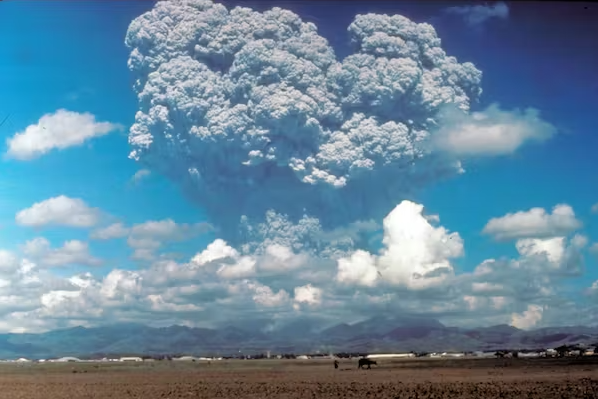Exploring the Potential of ‘Solar Dimming’ in Addressing Climate Change: Reasons and Methods

The severe warming anticipated could wreak havoc on vulnerable communities and ecosystems globally. It’s imperative to contemplate innovative solutions that have the potential to halt the
progression of climate change.
London: Recognizing the urgent need to address our climate crisis, where current trends indicate a shortfall in meeting our climate goals, with temperatures already at a concerning 1.26°C of warming in 2022 and an anticipated trajectory surpassing 1.5°C by the mid-2030s. Disturbingly, research indicates that existing climate policies may result in an alarming 2.5°C of warming by the close of this century.

The potential repercussions of such warming are dire, posing severe threats to vulnerable communities and ecosystems worldwide. It is imperative that we explore innovative approaches to halt climate change in its tracks.
Inspired by the aftermath of powerful volcanic eruptions such as Tambora (Indonesia) in 1815 and Pinatubo (Philippines) in 1991, during which global temperatures temporarily decreased, we find a possible solution. These eruptions introduced a haze of microscopic particles into the upper atmosphere, effectively dimming the Sun for several years. Mimicking this natural phenomenon could offer a novel strategy to combat climate change.
change lines Ash cloud of Pinatubo during the 1991 eruption.Dave Harlow / US Geological Survey, CC BY-NC-SA

Cooling the planet would work
Dimming the Sun wouldn’t perfectly reverse climate change. The Sun’s warming effect is strongest during the day, in the summer and at the Tropics, whereas greenhouse gasses warm everywhere and at all times.
However, we could create an even cooling effect across the world by adjusting where we release the particles. Research suggests that such an approach would greatly reduce climate risks.
Rising temperatures really matter. Species around the world are on the move, tracking familiar temperatures polewards as the planet warms up. But many won’t be able to keep pace with the changing climate and others have nowhere to go, so extinctions are projected to increase.
We are also seeing extreme heat that is edging closer to the absolute limits of the human body, putting lives at risk and limiting outdoor work.

As the planet heats up, warmer air is drawing more moisture from the soil in dry times, and dumping more out at once when it rains. This is making dry regions drier, wet regions wetter, and is intensifying both droughts and floods across the world.
Dimming the Sun would offset this effect. But it would still alter global wind and rainfall patterns.
Research indicates that this would mean smaller rainfall changes overall. However, a small minority of places could see more pronounced changes in rainfall compared to what they would face under climate change. Climate models disagree on the details of regional rainfall changes, so it’s unclear at this stage which regions would see the greatest change.
Blocking some sunlight would also be an effective way of keeping icy parts of the world frozen. Rising temperatures are causing the Antarctic and Greenland ice sheets to melt at an accelerating rate, driving up the global sea level. Climate change is also thawing permafrost (frozen soil that stores vast amounts of carbon) leading to the emission of more of methane and CO₂.

Lines:
Images: Ash cloud of Pinatubo during the 1991 eruption. Dave Harlow / US Geological Survey, CC BY-NC-SA
Implementing a strategy to cool the planet shows promise, though it’s important to acknowledge that dimming the Sun won’t be a perfect reversal of climate change. The Sun’s warming impact is most pronounced during daytime, in summer, and at tropical latitudes, whereas greenhouse gases contribute to warming across the globe continuously.
Nevertheless, a more evenly distributed cooling effect on a global scale could be achieved by strategically selecting release locations for the particles. Research indicates that such an approach holds potential for significantly mitigating climate risks.

The rising global temperatures have far-reaching consequences. Species are shifting their habitats towards the poles in response to the warming planet. However, many species are unable to adapt quickly enough, leading to projections of increased extinctions.
Extreme heat events are pushing towards the limits of human tolerance, endangering lives and limiting outdoor activities. The planet’s warming is altering precipitation patterns, causing drier regions to become even drier and wetter regions to experience more intense rainfall. This, in turn, exacerbates both droughts and floods worldwide.

Dimming the Sun could counteract some of these effects, but it would inevitably influence global wind and rainfall patterns. Research suggests that overall changes in rainfall would be modest, but specific regions might experience more significant alterations than they would under natural climate change. Currently, uncertainties persist regarding which regions would be most affected, as climate models differ in their predictions.
Furthermore, blocking sunlight proves effective in preserving icy regions. The accelerating melt of the Antarctic and Greenland ice sheets contributes to rising sea levels, while climate change also triggers the thawing of permafrost, releasing substantial amounts of methane and CO₂ into the atmosphere.
ChatGPT can make mistakes. Consider checking important information.
Melting ice can accelerate the pace of global warming. US Geological Survey, CC BY-NC-SA

Unintended Consequences
While the prospect of dimming the Sun holds the potential to keep the Earth’s temperature in check, it doesn’t tackle the root cause of the climate crisis: the accumulation of CO₂ and other greenhouse gases in the atmosphere. CO₂, in addition to its warming effect, contributes to ocean acidification, making it challenging for corals and other marine life to build their shells. Dimming the Sun wouldn’t address these underlying issues.
Moreover, there are collateral effects to consider. The introduction of a hazy layer of particles would lend a whiter hue to the sky. If we mimic volcanic eruptions by releasing sulfate particles into the upper atmosphere, we would inadvertently worsen the issue of acid rain.

These particles could also impact the ozone layer, responsible for shielding us from harmful UV rays. Studies indicate that an increased presence of sulfate particles in the upper atmosphere might impede the slow recovery of the ozone hole.
While these side effects raise valid concerns, they pale in comparison to the severe impacts of climate change. Recent research suggests that the health benefits derived from reduced extreme heat could outweigh the health impacts of these side effects by a ratio exceeding 50 to 1.
Paul Crutzen, a Nobel laureate recognized for his work on the ozone hole, acknowledged these side effects but argued for a serious consideration of dimming the Sun. In a 2006 article, he emphasized the urgent need to rapidly cut CO₂ emissions to obviate the necessity of solar dimming. Unfortunately, this aspiration seems far from realization.

Symptoms vs. Causes
The reality is that the aspirational goal of reducing CO₂ emissions has not materialized. Since Crutzen’s 2006 article, CO₂ emissions have surged by more than 15%. While the imperative to continue emission reduction efforts remains, a growing body of evidence suggests that solar dimming could effectively address the symptoms of climate change.
Although it might seem counterintuitive, the logic is clear: ice melts in warm conditions, heightened temperatures increase atmospheric moisture, and heat directly impacts life. While it’s premature to advocate for solar dimming today, dismissing the idea entirely could mean missing a valuable opportunity to mitigate climate change risks.

For those pressed for time, receive a weekly climate roundup in your inbox. Every Wednesday, The Conversation’s environment editor crafts Imagine, a concise email delving deeper into a single climate issue. Join over 20,000 readers who have already subscribed.
Author: Peter Irvine, Lecturer in Earth Sciences, UCL
Disclosure Statement: Peter Irvine receives funding from Horizon Europe and serves as a scientific advisor to the Degrees Initiative, an NGO supporting research into solar radiation modification geoengineering in the developing world.

Listen to the latest songs, only on JioSaavn.com. This article is republished from The Conversation under a Creative Commons license. Read the original article.




